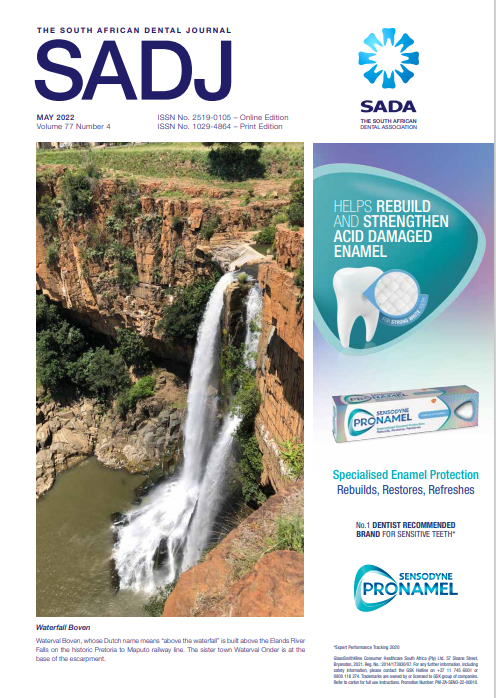The prevalence and classification of mandibular third molar impactions and associated second molar pathology in a Gauteng population group. A retrospective study.
DOI:
https://doi.org/10.17159/2519-0105/2022/v77no4a2Keywords:
postoperative, asymptomaticAbstract
An impacted tooth is one that has not erupted or is unlikely to erupt into its functional position within the dental arch1, and which has remained embedded in the jawbone or mucosa for more than 2 years following its physiological eruption time2 . It may be visible, not visible but palpable, or neither visible nor palpable but evident on a radiograph.1,3 Third molars are the most commonly impacted teeth followed by maxillary canines, with reported variations in prevalence amongst different population groups2,4. In 2000 The National Institute for Health and Clinical Excellence (NICE) issued guidelines stating that third molars should only be removed
if there is evidence of pathology, and advocated that the practice of prophylactic removal be discontinued.1
Downloads
References
McArdle LW, Renton T. The effects of NICE guidelines on the management of third molar teeth. British Dental Journal. 2012 14 May; 213:E8.
Al-Zoubi H, Alharbi AA, Ferguson DJ and Zafar MS. Frequency of impacted teeth and categorization of impacted canines: A retrospective radiographic study using orthopantomograms. Eu J Dent. 2017; 11 (1):117-121.
Bagheri SC, Bel RB, Khna HA. Current Therapy in Oral and Maxillofacial Surgery. 1st ed. St Louis: Elsevier Saunders; 2012.
Pedro FL, Bandeca MC, Volpata Le et al. Prevalence of impacted teeth in a Brazilian subpopulation. J Contemp dent Pract. 2014;15:209-213.
American Association of Oral and Maxillofacial Surgeons : Parameters of care: clinical practice guidelines for oral and maxillofacial surgery. 2007. American Association of Oral and Maxillofacial Surgeons Rosemont, Ill
Moynihan P and Petersen PE. Diet, nutrition and the prevention of dental diseases. Public Health Nutrition: 2004; 7(1A), 201–226 DOI: 10.1079/PHN2003589
American Association of Oral and Maxillofacial Surgeons White Paper: Management of Third Molar Teeth, 2016.
SASMFOS [Internet] SASMFOS Position Statement on Third Molar (Wisdom teeth) Surgery. [cited 2018 April 3]. Available from: http://sasmfos.org/files/sasmfos_third_molar_policy.pdf.
American Association of Oral and Maxillofacial Surgeons. White paper on why, when and how to treat third molar teeth (2011).Accessed at: https://www.prnewswire.com/news-releases/aaoms-white-paperdiscusses-why-when-and-how-to-treat-third-molarteeth-135889358.html; Accessed on 07-08-2020
Khawaja NA, Khalil H, Parveen K, Al-Mutiri A, Al-Mutiri S, Al-Saawi A. A Retrospective Radiographic Survey of Pathology Associated with Impacted Third Molars among Patients Seen in Oral & Maxillofacial Surgery Clinic of College of Dentistry, Riyadh. Journal of International Oral Health 2015; 7(4):13-17.
Susarla SM, Dodson TB. Preoperative computed tomography imaging in the management of impacted mandibular third molars. Journal of Oral and Maxillofacial Surgery. 2007;65:83.
Friedman JW. The prophylactic extraction of third molars: a public health hazard. Am J Public Health. 2007; 97:1554–1559
Trademarks are owned by or licensed to GSK group of companies. Refer to carton for full use instructions. Promotion Number: PM-ZA-SENO-21-00038.16239 Pronamel Strip ad PRESS.indd 1 2021/03/12 15:29204 > RESEARCH www.sada.co.za / SADJ Vol. 77 No. 4
Ye Z, Qian W, Wu Y, Sun B, Zhiyao L, Ling F, Xiang F, Zhu M, Zhang Y. Is prophylactic extraction of mandibular third molar indicated? A retrospective study. Research Square. 2020
Saha N, Kedarnath NS, Singh M. Orthopantomography and Cone-Beam Computed Tomography for the Relation of Inferior Alveolar Nerve to the ImpactedMandibular Third Molars. Ann Maxillofac Surg 2019;9:4-9.
Monaco G, De Santis G, Pulpito G, Gatto MRA, Vignudelli E, Marchetti C. What Are the Types and Frequencies of Complications Associated With Mandibular Third Molar Coronectomy? A Follow-Up Study. Journal of Oral and Maxillofacial Surgery. 2015 Jul; 73(7): 1246-1253.
Ecuyer J, Debien J. Surgical deductions. Actual Odontostomatol. 1984; 148: 695.
Monaco G, D’Ambrosio M, De Santis G, Vignudelli E, Gatto MRA, Corinaldesi G. Coronectomy: A Surgical Option for Impacted Third Molars in Close Proximity to the Inferior Alveolar Nerve—A 5-Year Follow-Up Study. Journal of Oral and Maxillofacial Surgery. 2019; 77:1116-1124.
Ruga E, Gallesio C, Boffano P. Mandibular Alveolar Neurovascular Bundle Injury Associated With Impacted Third Molar Surgery. Journal of Craniofacial Surgery. 2010 Jul ; 21(4): 1175-1177.
Da Costa MG, Pazzini CA, Pantuzo MCG, Jorge MLR, Marques LS. Is there justification for prophylactic extraction of third molars? A systematic review. Braz Oral Res. 2013 Mar-Apr;27(2):183-8 .
Laskin DM. Evaluation of the third molar problem. J Am Dent Assoc. 1971 Apr;82(4):824-8.
Schulhof RJ. Third molars and orthodontic diagnosis. Journal of Clinical Orthodontics. 1976 Apr;10(4):272-81.
Lysell L, Rohlin M. A study of indications used for removal of the mandibular third molar. Int J Oral Maxillofac Surg. 1988 Jun;17(3):161-4.
Stanley HR, Alattar M, Collett WK, Stringfellow HR Jr, Spiegel EH. Pathological sequelae of “neglected” impacted third molars. J Oral Pathol. 1988 Mar;17(3):113-7.
McArdle LW, Renton TF. Distal cervical caries in the mandibular second molar: an indication for the prophylactic removal of the third molar? British Journal of Oral and Maxillofacial Surgery. 2006;44:42–5.
McArdle LW, McDonals F, Jones J. Distal cervical caries in the mandibular second molar: an indication for the prophylactic removal of third molar teeth? Update. British Journal of Oral and Maxillofacial Surgery 2014: 185–189.
Polat HB, Ozan F, Kara I, Ozdemir H, Ay S. Prevalence of commonly found pathoses associated with mandibular impacted third molars based on panoramic radiographs in Turkish population. Oral Surg Oral Med Oral Pathol Oral Radiol Endod 2008;105:e41-e47.
Pell GJ, Gregory GT. Impacted mandibular third molars: Classification and modified technique for removal. The Dental Digest 1933 Sep; 39(9): 325-338.
Rood JP, Shehab BA. The radiological prediction of inferior alveolar nerve injury during third molar surgery. Br J Oral Maxillofac Surg. 1990;28:20-5.
Mitra R, Prajapti VK, Vinayak KM, Nath S, Sharma N. Prevalence of Mandibular Third Molar Impaction. International Journal of Contemporary Medical Research. 2016;3(9): 2625-2626.
Downloads
Published
Issue
Section
License

This work is licensed under a Creative Commons Attribution-NonCommercial 4.0 International License.





.png)